PCT Yearly Review: Developments and Performance
Download [PDF]
- PREFACE
- 1. HIGHLIGHTS
- 2. FILINGS OF PCT APPLICATIONS
- 3. ANALYSIS OF PCT APPLICATIONS
- 4. PERFORMANCE OF THE INTERNATIONAL PATENT SYSTEM
- 5. ELECTRONIC ENVIRONMENT AND THE PCT
- 6. DISSEMINATION OF PCT AND PATENT INFORMATION
- 7. DEVELOPMENTS RELATED TO THE PCT LEGAL FRAMEWORK
- 8. STATISTICAL TABLE
- 9. GLOSSARY
- 10. PCT CONTRACTING STATES
- 11. MORE RESOURCES ON THE INTERNET
PREFACE
The Patent Cooperation Treaty
Since entering into force in 1978, the Patent Cooperation Treaty (PCT) offers inventors and industry an advantageous route for obtaining patent protection internationally. By filing one "international" patent application under the PCT, protection of an invention can be sought simultaneously in each of a large number of countries. Both applicants and patent Offices of the 138 PCT Member States benefit from the uniform formality requirements, the international search and preliminary examination reports and from the centralized international publication provided by the PCT system. The national patent granting procedure and the related expenses are postponed, in the majority of cases, by up to 30 months from priority date (or even longer in the case of some Offices) as compared with the traditional patent system. At the end of this period, the applicant should have received important value-added information concerning the likelihood of obtaining patent protection.
The graph below shows an overview of the main processing stages of patent applications within the international phase of the PCT system and their related timelines.
Overview of the PCT System
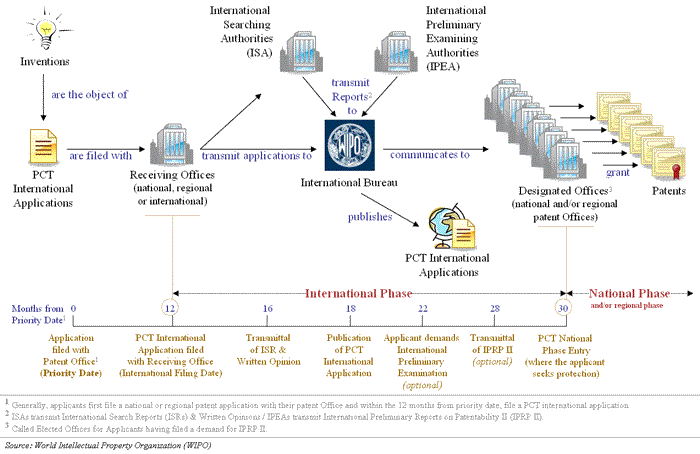
- An applicant using the PCT system must file a PCT international application at a receiving Office and choose an International Searching Authority that will provide him with a report and a written opinion on the patentability of his invention. The International Bureau of the World Intellectual Property Organization then publishes the application and communicates all necessary documents to patent Offices party to the PCT system. The applicant can choose to file a demand for a second evaluation of the patentability of his invention with an International Preliminary Examining Authority. The applicant has, in general, 30 months from the priority date to enter the PCT national phase in countries or regions in which he seeks protection.
PCT filing
A patent applicant who wishes to protect his invention in more than one country using the PCT system should file an international application under the PCT with the competent receiving Office. Generally, applicants first file a patent application with their patent Office and within 12 months from priority date, file their international application under the PCT.
International Bureau
The receiving Office transmits a copy of the PCT international application to the International Bureau (IB) of WIPO. The IB is responsible for:
- receiving and storing all application documents;
- performing a second formalities examination;
- publishing the application and related documents on PATENTSCOPE® search service;
- translating the title and abstract of the PCT international application and certain associated documents into English and/or French, where necessary;
- communicating documents to Offices and third parties;
- providing legal advice on request to users; and
- providing PCT-related assistance to PCT member States.
The applicant must pay an international filing fee of approximately 1,400 Swiss Francs (CHF) and where the PCT international application contains more than 30 pages, an additional fee per sheet of approximately 15 CHF (a fixed rate applies in some cases). Up to approximately 300 CHF in fee reductions are available to applicants who file electronically. In addition, applicants from low-income countries are entitled, under specified conditions, to a 75% reduction of the international filing fee and handling fee.
International Search
The PCT international search is carried out by a patent Office appointed to act as an International Searching Authority (ISA) within the PCT minimum documentation prescribed in the Treaty. The International Search Report (ISR) contains a list of the documents with indications of relevance to the patentability, namely novelty and inventive step (non-obviousness). In addition, the ISA establishes a written opinion on patentability, which gives the applicant a detailed analysis of the invention.
The ISR and the written opinion are communicated by the ISA to the applicant normally by the fourth or fifth month after the PCT international application has been filed. Applicants must pay a search fee which varies from approximately 244 to 2,274 US dollars1 (USD) according to the ISA chosen.
International Preliminary Examination
The international preliminary examination is an optional procedure where a second evaluation of the patentability of the invention can be sought from the International Preliminary Authority (IPEA).
The preliminary examination fees vary from approximately 200 to 2,420 USD depending on the IPEA chosen. A handling fee of approximately 171 USD also applies.
PCT National Phase
An applicant who has decided to proceed further with his PCT international application must, before the end of the 30th month from the priority date (or even longer in the case of some Offices), fulfill the requirements for entry into the PCT national phase at the patent Offices of or acting on behalf of States in which he seeks protection. The national or regional patent Offices concerned then begin the granting procedure under the national laws. In addition to paying the official fees, the applicant usually has to appoint local agents and have the application translated.
In addition to important value-added information concerning the likelihood of obtaining patent protection, a PCT applicant saves on time and costs, i.e. the work performed during the international processing is generally not repeated at each Office and legal and translation costs are postponed.
For further information, please refer to the WIPO publication: Protecting Your Inventions Abroad2
Statistical Sources
The statistics in this annual review are based on two sources of data. For the international phase of the PCT System, data originate from the WIPO statistical database. Provisional estimates have been made due to the fact that WIPO continues to receive PCT international applications filed at receiving Offices in 2007 after the publication of this review.
For the national phase of the PCT System, the statistics are based on data supplied to WIPO by national and regional patent Offices, often 6 months or more after the end of the year concerned, meaning that the latest available year to date is 2006. Data may be missing for some Offices or incomplete for some countries of origin. No estimates are made for the data concerning national phase.
The figures shown in this review are thus subject to change.3
Readers are welcome to use the information provided in this review, but are requested to cite WIPO as the source. Tables and graphs can be downloaded in image format at https://www.wipo.int/ipstats/en/statistics/pct/.
Highlights
In 2007, the international patent system saw several notable developments.
- Increase in PCT Filings - In 2007, 158,400 PCT international applications were filed4, representing a 5.9% rate of growth over the previous year. For the fourth year running, the most notable growth rates came from countries in North East Asia which accounted for over a quarter (25.4%) of all PCT international applications.
- North East Asian Countries Consolidate Positions - The Republic of Korea overtook France as the 4th biggest country of origin of PCT filings, with an 18.9% growth in filings compared to 2006, while China dislodged the Netherlands from its position as 7th biggest country of origin, with a 38.5% growth in filings. Maintaining their positions among the top 10 countries of origin were United States of America (1st), Japan (2nd), Germany (3rd), France (5th), United Kingdom (6th), the Netherlands (8th), Switzerland (9th) and Sweden (10th).
- Changes in Top Applicants List - Matsushita of Japan moved into 1st place (2,100 applications published in 2007), overtaking the Dutch multinational Philips Electronics N.V. (2,041 applications published in 2007). Siemens (Germany) (1,644) retained 3rd place. Huawei Technologies of China moved up 9 places to become the 4th largest applicant with 1,365 applications published in 2007. These were followed by Bosch (Germany) (1,146), Toyota (Japan) (997), Qualcomm (USA) (974), Microsoft (USA) (845), which jumped 38 places to 8th place, Motorola (USA) (824) and Nokia (Finland) (822). Among the 20 top filing companies, six were from the USA, six from Japan and three from Germany.
- Fields of Technology - The largest proportion of PCT international applications published in 2007 related to the telecommunications (10.5%), information technology (10.1%) and pharmaceuticals (9.3%) sectors. The fastest growing technology areas are nuclear engineering (+24.5%) and telecommunications (+15.5%), however, in the case of nuclear engineering, the total numbers are still relatively low compared to those of other fields of technology.
- Full Text Search on PATENTSCOPE® search service - Since 2007, PATENTSCOPE® search service enables users to make full text search within the entire collection of PCT international applications published5 since the beginning of the PCT system in 1978, which represents over 1.3 million PCT international applications.
- Utility Model Statistics - WIPO now publishes statistics on utility models filed, granted and in force - including PCT national phase entries - by country of origin and by patent Office.
FILINGS OF PCT APPLICATIONS
2.1 PCT International Application Filing Trends
The graph below shows the number of PCT international applications filed since their inception in 1978. PCT international application filings are patent applications filed under the Patent Cooperation Treaty.
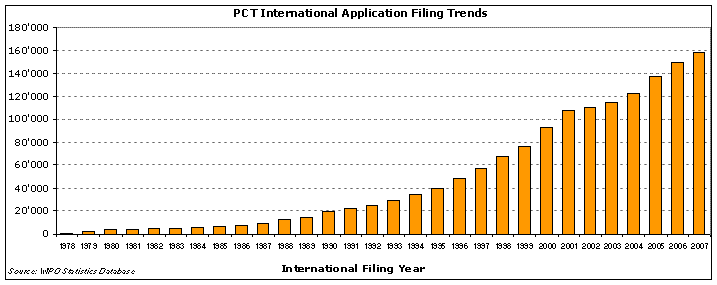
- In 2007, 158,4006 PCT international applications were filed.
- Since 1978, approximately 1.49 million PCT international applications have been filed.
The graph below shows the annual growth rate of PCT international applications filed since 1980.
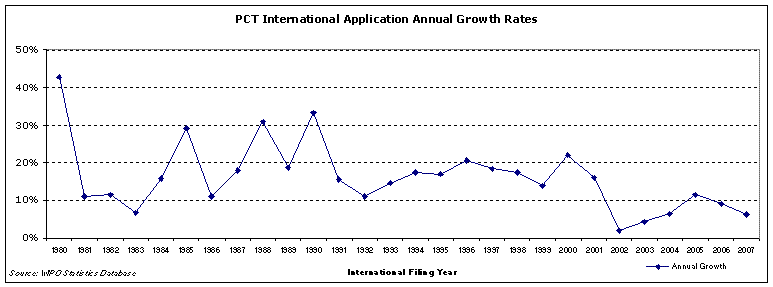
- In 2007, the growth rate over the previous year’s level was 5.9%.
2.2 PCT National Phase Entry Trends
The graph below shows the number of PCT national phase entries (including regional phase entries) since 1995. The PCT national phase statistics illustrate the number of PCT international applications where applicants actually seek protection for their inventions in other countries.

- In 2006, about 376,000 PCT international applications entered the national phase.
The graph below shows the annual growth rate of PCT national phase entries since 1996.
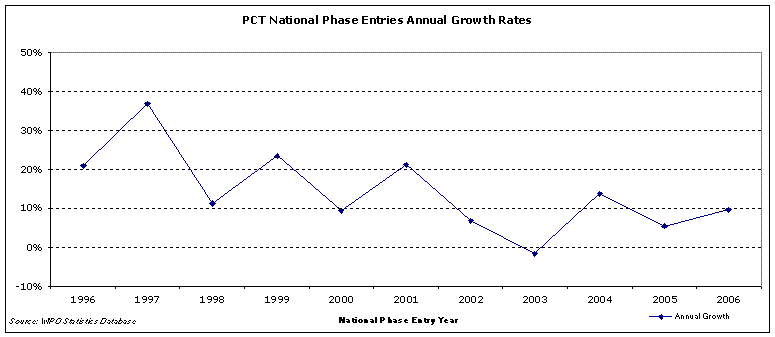
- In 2006, the number of PCT national phase entries increased by 9.5% over 2005.
ANALYSIS OF PCT APPLICATIONS
3.1 Top 15 Countries of Origin
The table below shows the top 15 countries where applicants filed most PCT international applications in 2007. See the statistical table in the annex for a complete list of countries. The country of origin is taken to be the country of residence of the first-named applicant in the PCT international application.
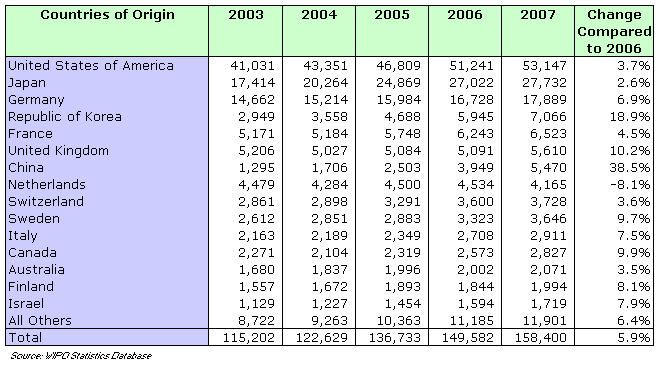
- The Republic of Korea (4th) and China (7th) both gained one place over the previous year, with a respective growth of 18.9% and 38.5%.
- Together, the European Patent Convention Member States account for 52,931 PCT international applications, which is an increase of 5.7% over 2006.
3.2 PCT and Developing Countries
The table below shows the number of PCT international applications filed by applicants from a selection of developing countries.

- As reflected in the statistical table in the annex, the number of PCT international applications filed by applicants from developing countries and least developed countries is low compared to the number of PCT national phase entries at their patent Offices.
3.3 Top 20 PCT Applicants
The table below shows the top 20 PCT applicants based on the number of PCT international applications published in 2007.
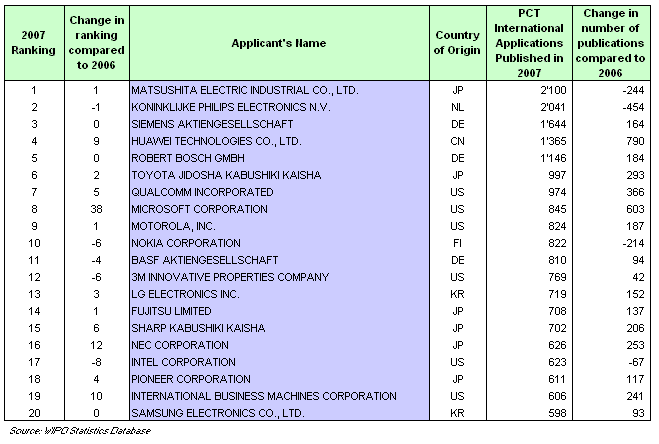
- Matsushita Electric Industrial Co. of Japan moved into 1st place, overtaking the Dutch multinational Philips Electronics N.V., whereas the Chinese multinational Huawei Technologies gained 9 places up to 4th position.
- The 3 main changes in ranking originate from the US-based multinational Microsoft Co. (+38), the Japanese NEC Co. (+12) and the US IBM Co. (+10).
- In 2007, 143,000 applicants and 369,000 applicants/inventors are named in published PCT international applications.
3.4 Filings by Medium of Filing
The graph and table below show the changing distribution of filings on paper, on paper together with a diskette or other physical medium (CD-R, DVD-R) prepared electronically using the PCT-EASY functionality, and on fully electronic medium since 2003. The fully electronic filings comprise XML and PDF filings as well as web-based electronic filings (EFS-Web) at the United States Patent and Trademark Office (USPTO).
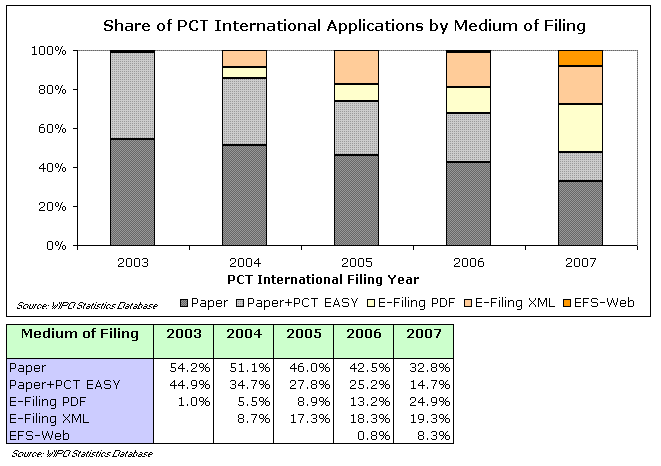
- During 2007, the majority of PCT international application filings (52.5%) were made using a fully electronic medium. If PCT EASY, the combined paper and electronic filing media, is added to this sum, the share of filings by electronic means rises to 67.2%.
- In 2007 the patent Office of China (from 1 May) announced that it accepts fully electronic filings thereby bringing the total number of offices allowing fully electronic filings to 20.
- The increase of 69.7% in fully electronic filings over the previous year’s total can be primarily accounted for by Chinese and US electronic filings, as the overall numbers of filings at these Offices represent respectively 3.4% and 33.4% of the total PCT international applications filed in 2007.
3.5 Filings by Language of Filing
The table below shows the number of PCT international applications according to their language of filing. A PCT international application may be filed in any language accepted by the relevant receiving Office.
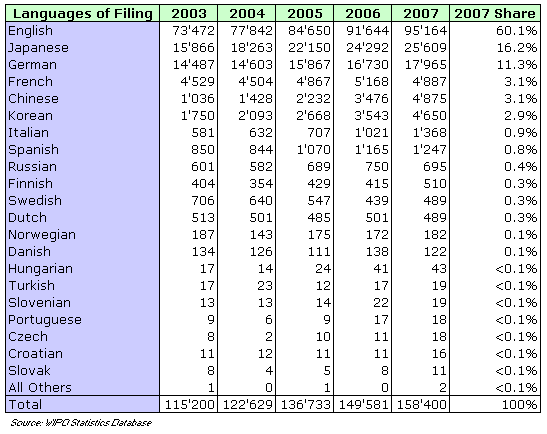
- Compared to 2006, the top five languages of filing changed with the move of Chinese into 5th place (+1 place) overtaking Korean (-1 place).
3.6 Publications by Language of Publication
The table below shows the number of PCT international applications according to their language of publication. PCT international applications must be published in one of the official publication languages (currently Arabic, Chinese, English, French, German, Japanese, Russian and Spanish).
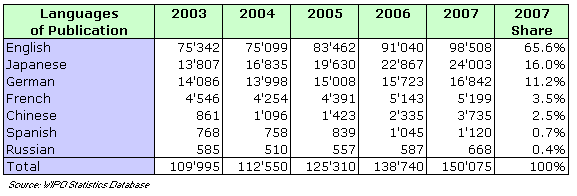
- Chinese as a publication language has increased by 60% as compared to 2006, followed by Russian (+13.8%) and English (+8.2%).
3.7 Publications by Technical Field
The table below shows the technical fields of PCT international applications published and the annual growth in 2007. In this table, PCT international applications are classified according to 30 classifications7 based on the International Patent Classification (IPC) system. As a PCT international application can be assigned multiple IPC symbols that correspond to more than one technical field, the total count by technical field is greater than the total number of PCT international applications published.
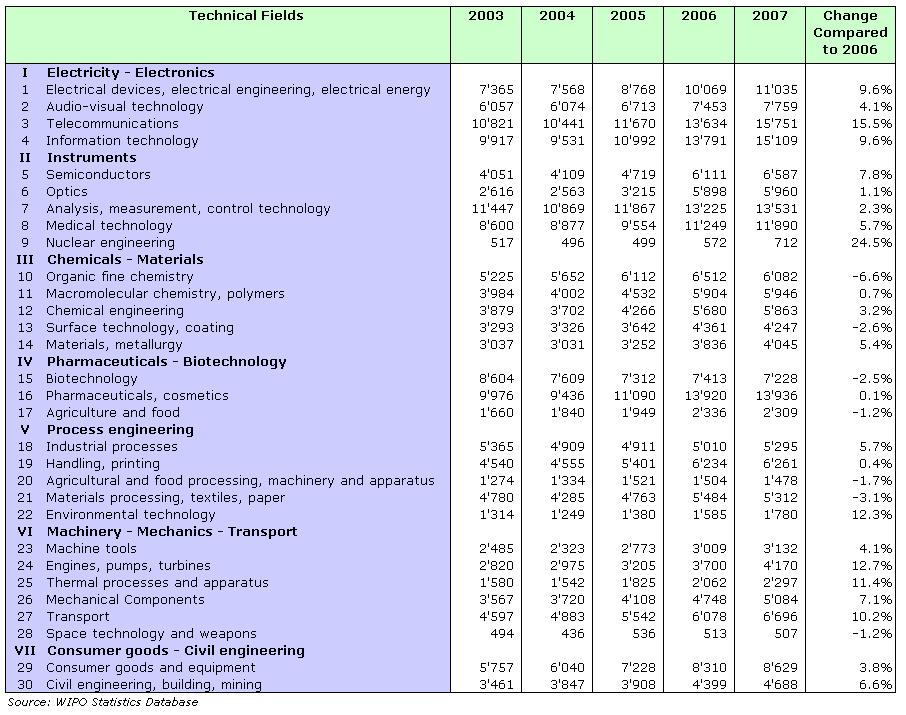
- The technical fields with the greatest number of PCT international applications published in 2007 were in the field of telecommunications, information technology and pharmaceuticals.
- The fastest growing technical fields in 2007 were nuclear engineering (+24.5%) and telecommunications (+15.5%); however, in the case of nuclear engineering, the total numbers are still relatively low compared to those of other fields of technology.
3.8 PCT National Phase Entries
The national phase follows the international phase of the PCT procedure and consists of the entry and processing of the PCT international application in the individual countries or regions in which the applicant seeks protection for his invention. The patent Offices where the applicant seeks protection are called designated Offices or (when the applicant has filed a demand for preliminary examination) elected Offices.8
3.8.1 PCT National Phase Entries by Country of Origin
The table below shows the number of PCT national phase entries according to the country of origin of the first named applicant in the PCT international application.
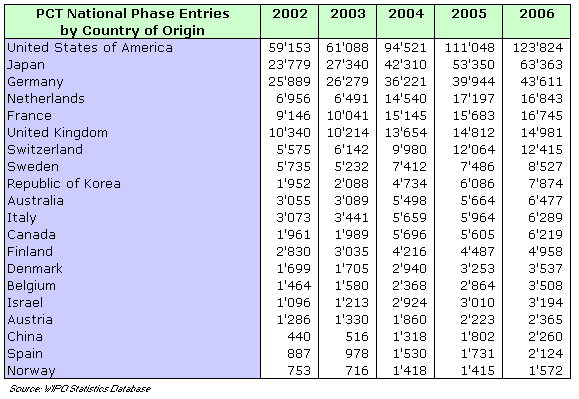
- The highest growth rates in 2006 compared with the previous year’s total are attributed to applicants originating from the Republic of Korea (+29.4%), followed by those from China (+25.4%) and Spain (+22.7%).
3.8.2 PCT National Phase Entries by Designated/Elected Office
The data in the table below shows the number of PCT national phase entries before designated and elected Offices.
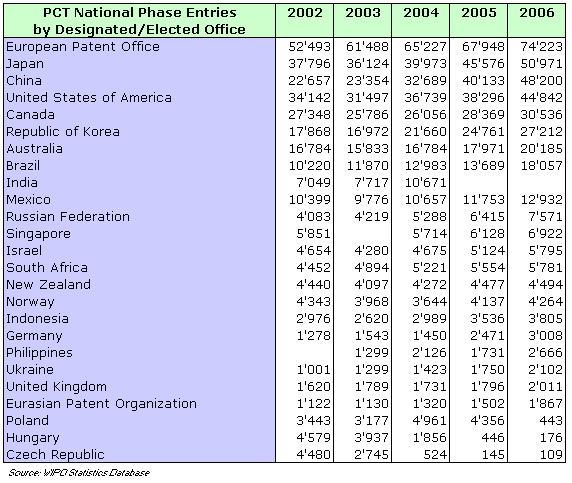
- The patent Offices, acting as designated or elected Offices, with the highest growth compared to 2005 are those of Brazil (32%), Germany (+22%) and China (+20%).
- Czech Republic, Hungary and Poland became member States of the European Patent Convention (EPC) in 2002, 2003 and 2004 respectively. A PCT applicant seeking protection in any of the States member to the EPC can generally choose between entering the national phase at a national Office or the regional phase at the European Patent Office (EPO). As a result, the number of PCT national phase entries at some European national Offices is lower than would otherwise be expected.
- It should be noted that the PCT national phase route is closed for France, Italy, the Netherlands and several other EPC member States. A PCT applicant seeking protection in those countries must therefore enter the PCT regional phase at the EPO.
PERFORMANCE OF THE INTERNATIONAL PATENT SYSTEM
4.1 Receiving Offices
PCT International applications are filed first with a receiving Office (RO), which may be a national or regional Office or the International Bureau. In 2007, 110 Offices were acting as ROs.
4.1.1 Top 15 Receiving Offices
The table below shows the Top 15 ROs according to the number of PCT international applications filed. The statistical table in the annex shows the number of PCT international applications filed in 2007 for each of the 110 ROs.
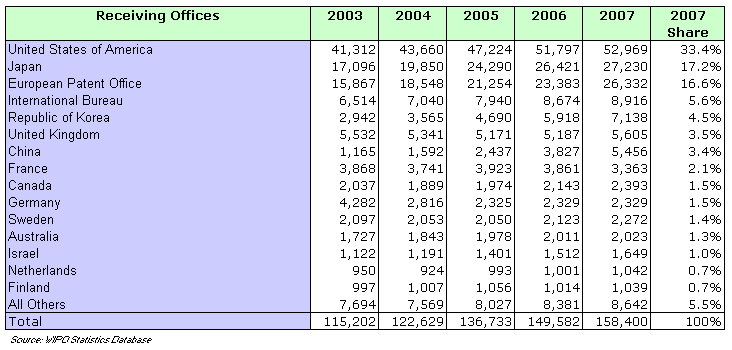
- PCT international applications filed at the top three ROs account for two-thirds of the total filings in 2007.
- The ROs with the fastest growing numbers of PCT international applications filed in 2007 are the ROs of China (+42.6%), the Republic of Korea (+20.6%) and the European Patent Office (+12.6%).
4.1.2 Transmittal of International Applications to the International Bureau as Receiving Office
Where a PCT international application is filed with a receiving Office that cannot accept this application due to the nationality or the country of residence of the applicant, the language of filing or another reason, this application is forwarded to and considered as having been received by the International Bureau acting as the RO9. In 2007, 1,131 PCT international applications filed were transmitted to the International Bureau as RO, which represents 0.7% of all PCT international applications filed that year.
4.2 International Bureau
The International Bureau (IB) is responsible for the administration of the international phase of the PCT System.
4.2.1 PCT Operations Workload and Personnel
In addition to its task as RO for applications from all PCT Contracting States, WIPO, through its PCT Operations Division, manages certain processing tasks with respect to all PCT international applications filed with all ROs worldwide. Among others, these processing tasks consist of the following: formality examination, translation of abstracts and titles and publication of PCT international applications.
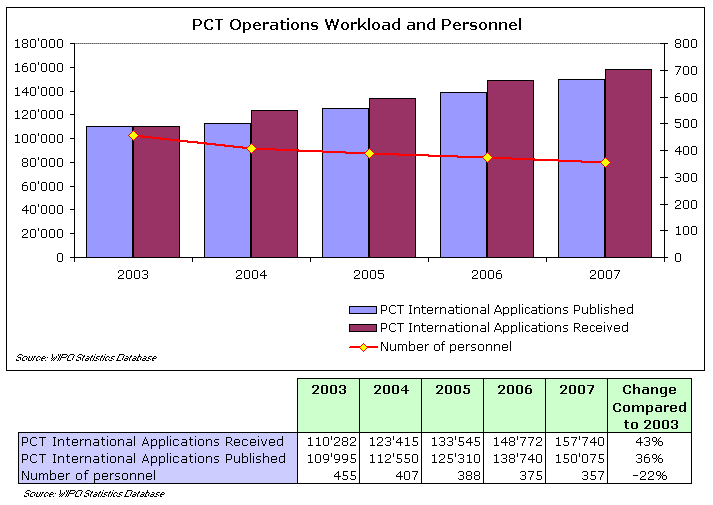
- Over the past five years, the number of PCT international applications received by the IB increased by 43% while the number of personnel processing PCT international applications decreased by 22%.
- The figure for PCT international applications received at the IB differs from that of applications published due to the fact that PCT international applications are usually published six months after their receipt by the IB.
4.2.2 Publication and Republication Timeliness
The PCT international application and related documents are published after the expiration of 18 months from the priority date unless the applicant requests early publication of the PCT international application or unless the application is withdrawn or considered withdrawn. At the time of publication, the International Bureau proceeds to the publication of the PCT international application even in the absence of the International Search Report (ISR) and republishes part of the PCT international application together with the ISR after the latter arrives.
Publication
The graph below shows the timeliness of publication by the International Bureau of PCT international applications after the expiration of 18 months from the priority date.
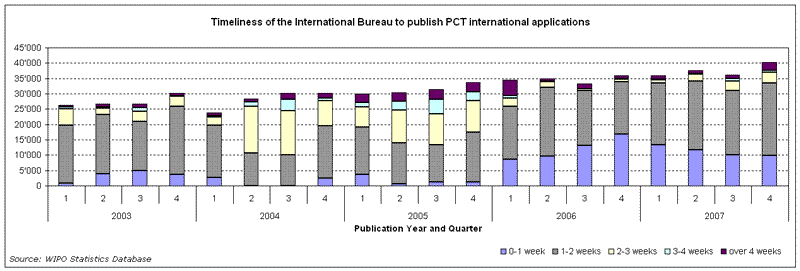
- In 2007, 88% of PCT international applications were published within two weeks following the expiration of 18 months from the priority date, 95% were published within three weeks and 96% within four weeks.
Republication
The graph below shows the timeliness of republication by the International Bureau of PCT international applications with ISRs in the cases where the ISR was missing upon publication.
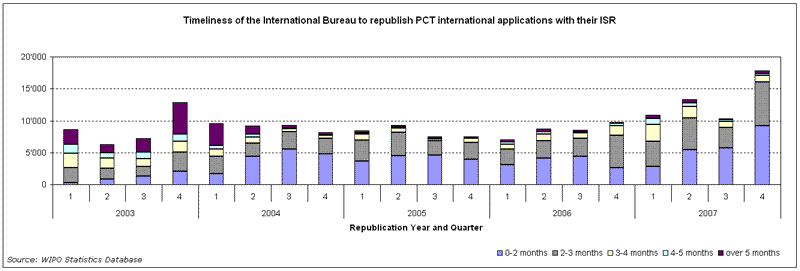
- In 2007, 44% of republications were published within two months of receipt of the ISR by the International Bureau, 80% within three months and 93% within four months.
4.2.3 Translation and Terminology
The main objective underlying the International Bureau's efforts in the area of translation is to enhance the patent system's disclosure function by making the technological information embodied in PCT international applications accessible in languages other than those in which the original documents were filed. In order to meet this policy objective, the International Bureau translates and publishes the abstracts, titles and text matter in the drawings of PCT international applications into English and French, and ISR and IPRP II into English. In 2007, the International Bureau produced approximately 206,000 abstract translations, 45,000 IPRP II and 2,000 ISR translations.
In view of the continuing growth trend in filings from North East Asian countries, the International Bureau has attached great importance to enhancing the necessary human and technical resources that will ensure access to information in languages from this region.
The International Bureau has relied heavily on outsourcing as a means of absorbing increasing translation commitments, which are being met by combining outsourcing activities with an appropriate level of translations produced internally at the International Bureau. A series of control and feedback measures to ensure the quality of externally produced translations were implemented in 2007 as new and more outsourcing agencies were engaged in the second half of that year. These quality management measures should have a decisive impact on other language-related products and services that the International Bureau is in the process of developing and making available to the patent system and the general public.
The graph below shows the distribution of translations done directly by the International Bureau or outsourced in 2007.
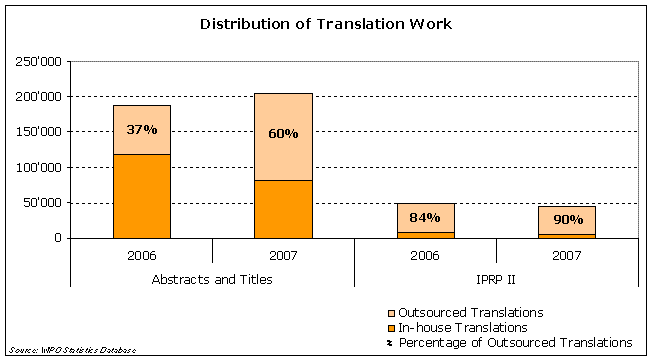
The International Bureau has placed more emphasis on the introduction of information technology in the translation process and has reoriented its translation activities with a view to creating a multilingual search facility for integration into PATENTSCOPE® search service. There has been a renewed emphasis on terminology with the aim of creating a multilingual terminology database in all PCT publication languages, which will be enriched with the inclusion of Korean and Portuguese in 2009. The terminology database already containing thousands of terms is intended to be the backbone of the cross-language information retrieval system and machine translation service provided in PATENTSCOPE® search service.
4.3 International Search
International Searching Authorities (ISAs) are appointed by the PCT Assembly to carry out international searches. In 2007, 12 national Offices or intergovernmental organizations were acting as International Searching Authorities. These Offices produce International Search Reports (ISRs) and the written opinions of the ISA. The ISR contains citations of documents considered to be relevant to the claimed invention (i.e. prior art), the classification of the subject matter of the invention and an indication of the fields searched as well as which electronic databases have been consulted. The ISR and the written opinion are communicated by the ISAs to applicants normally by the fourth or fifth month after the PCT international application has been filed.
4.3.1 Distribution by International Searching Authorities
The chart below shows the number of PCT international applications filed according to their selected ISAs.
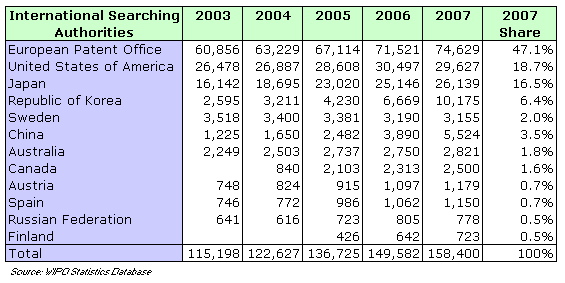
- The patent Offices acting as ISAs that experienced the largest growth rates compared to 2006 were the Offices of the Republic of Korea (+87.5%), China (+70.6%) and Spain (+37.7%).
- Since 2006, the Korean Intellectual Property Office has been acting as an International Searching and Preliminary Examining Authority for PCT international applications filed with the United States Patent and Trademark Office acting as receiving Office.
4.3.2 Timeliness
The graph below shows the transmittal timeliness of ISRs to the International Bureau.
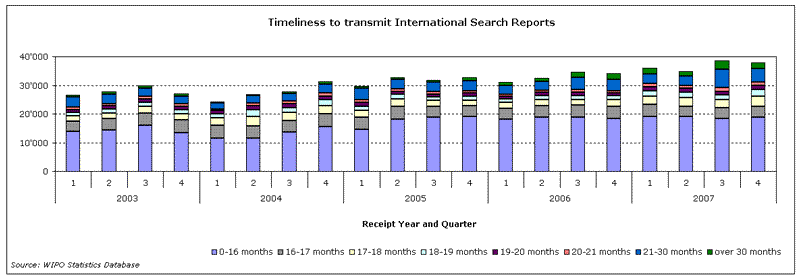
- In 2007, 51% of ISRs were received by the International Bureau before 16 months from the priority date and 18% after 20 months from the priority date.
4.4 International Preliminary Examination
International Preliminary Examining Authorities (IPEAs) are appointed by the PCT Assembly to carry out the international preliminary examination procedure. In 2007, 12 national Offices or intergovernmental organizations were acting as IPEAs. Their task is to establish the International Preliminary Examination Report (IPER) which is a preliminary, non-binding opinion, carried out at the request of the applicant, stating if the claimed invention appears to be novel, to involve an inventive step (to be non-obvious) and to be industrially applicable. As of 1 January 2004, this report is also known as the "international preliminary report on patentability (Chapter II of the PCT)".
4.4.1 Distribution by International Preliminary Examining Authorities
The graph below shows the number of demands for International Preliminary Examination since 2003. The decrease is due to a modification of the time limit for entry into the PCT national phase, in force since April 2002, and to the introduction in 2004 of the written opinion of the International Searching Authority that is now provided with the International Search Report for all PCT international applications.
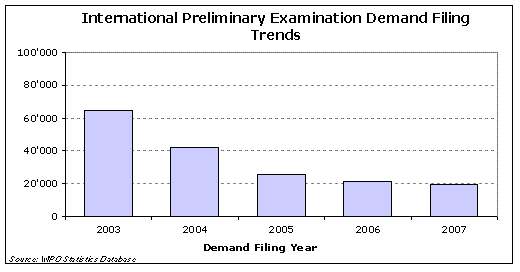
The table below shows the number of demands for International Preliminary Examination at each Examining Authority.
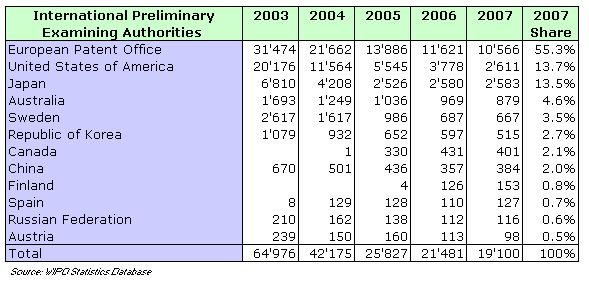
4.4.2 Timeliness
The data in the graph below shows the transmittal timeliness of IPERs to the International Bureau.
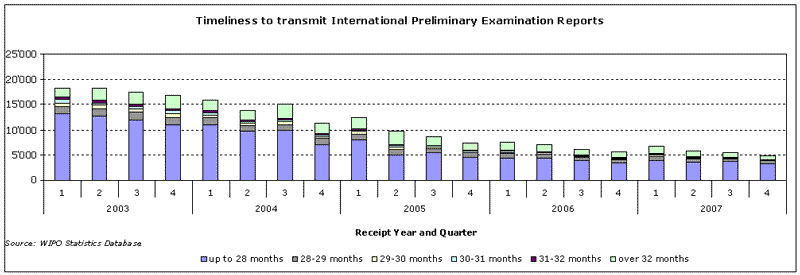
- In 2007, 63% of IPERs were received by the International Bureau before 28 months from the priority date and 18% after 32 months from the priority date.
ELECTRONIC ENVIRONMENT AND THE PCT
5.1 Electronic Filing
In 2007, 52.5% of all PCT international applications were filed fully electronically and one new Office, namely the Chinese patent Office, announced its acceptance of fully electronic filings bringing the total to 20 Offices (see paragraph 3.4). Together with the paper and electronic filing media, i.e. PCT EASY, 67.2% of PCT international applications were filed electronically in 2007.
Increased electronic filings and the receipt by the International Bureau of larger numbers of PCT documents in electronic format have undoubtedly contributed to the International Bureau’s ability to process more work with less staff (see paragraph 4.2.1). Apart from this general observation, electronic filings also impact other aspects of the International Bureau’s work as illustrated by the graphs below.
As shown in the graph below, most data input errors committed in 2007 by the International Bureau concern purely paper filings, whereas such errors are the least prevalent for XML filings.
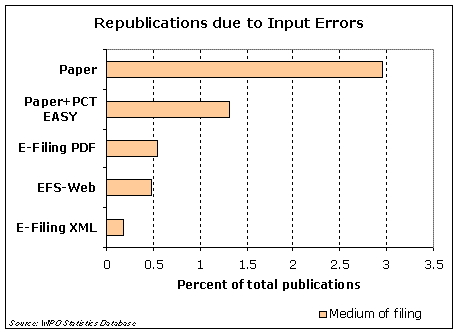
However, as shown in the graph below, the formality examination of XML filings by the International Bureau, on average, takes more time than that of the other filing formats, including paper. This is explained by the fact that the International Bureau’s procedures and systems have been designed to handle various document formats and, as yet, have not been optimized for XML. These procedures and systems as well as the medium of filing have, however, no negative impact on the timeliness to publish PCT international applications.
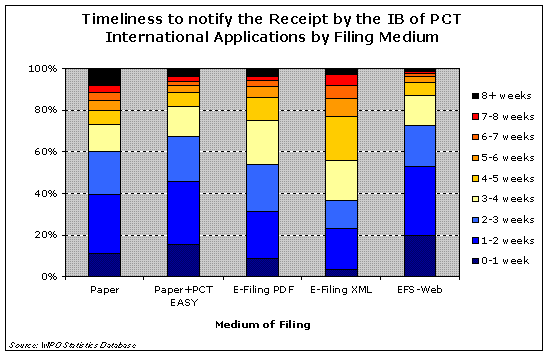
5.2 Electronic Exchange of Data between the International Bureau and Offices
Since 2007, all documents and data transmitted to the International Bureau by the USPTO are sent via an electronic means and processed electronically. This development has brought the percentage of documents received in electronic form to 80% and has permitted the International Bureau to increase internal efficiency by eliminating the need to scan a considerable volume of paper documents.
5.3 Electronic Processing of PCT International Applications within the International Bureau
In 2007, the International Bureau capitalized further on fully electronic processing of PCT international applications:
- by extending the electronic translation workflow to external translation partners, and;
- by starting to lay the technical groundwork to extend electronic communication of PCT notifications sent to applicants and agents.
DISSEMINATION OF PCT AND PATENT INFORMATION
6.1 PATENTSCOPE® Search Service
The PATENTSCOPE® search service provides access to the technology contained in over 1.3 million published PCT international applications since 1978.
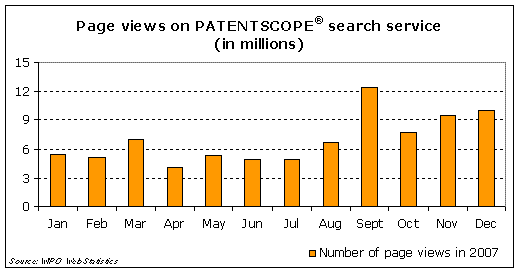
- The Internet traffic has nearly doubled between January and December 2007.
In 2007, a number of enhancements have been made to PATENTSCOPE® search service in order to add content, increase the functionality of the service and make it more user friendly. The main changes are listed below:
Full text search for data back to 1978
Since March 26, 2007, the PATENTSCOPE® search service enables users to search full text data from 1978 to the present day for the Latin character languages (English, French, German and Spanish). Prior to that date, it was possible to search the full text of claims and descriptions back to July 1998 only. The full text data includes all published text of PCT international applications (including bibliographic data, claims and detailed descriptions) that were filed in English, French, Spanish or German. This 20-year extension of availability of claims and descriptions means users get much reliable results than searching front page bibliographic data only.
Searchable PCT national phase data
In May 2007, it became possible to carry out a search based on PCT national phase entry information for over 30 countries (the latest data added being that of the EPO and the Czech Republic). The search can be done by national phase country code, application number, entry date and/or entry type.
Availability of applicant's informal comments on written opinion of the International Searching Authority
Applicant's informal comments on the written opinion of the International Searching Authority are now available on PATENTSCOPE® search service for all PCT international applications filed on or after January 2004. It should be noted that these documents are only available after 30 months from the first priority date.
New presentation of PCT documents
The presentation of PCT documents has been enhanced such that the official publication of PCT international applications is easier to find and identify. These changes are also aimed at providing a better navigation to the different renditions of documents (PDF, HTML, ZIP, etc).
Changes in the publication of sequence listings
All sequence listings are now treated in the same manner regardless of their medium of filing. They are published as separate documents under the Documents tab in PATENTSCOPE® search service and on the dedicated sequence listings page where they can be downloaded directly10. This change resulted in improving the reliability, consistency and completeness of the publication of sequence listings.
Technology Focus: A new feature of PATENTSCOPE® search service
This feature linked to PATENTSCOPE® search service provides, through technology reports as well as pre-defined searches of the latest published PCT international applications, a quick visualization of developments in selected technologies. The technologies have been selected on the basis of public interest or relevance to prominent areas of public policy (e.g. energy, textiles and traditional medicines).
The search terms are primarily based on the international patent documents according to their technological subject. When searching within technologies, users are able to refine their search by entering relevant keywords.
Expanded PATENTSCOPE®glossary
Since 28 March 2007, the PATENTSCOPE® glossary has been extended to include a large number of additional terms. The glossary is intended to assist users with terminology related to the PATENTSCOPE® search service.
6.2 New Internet Resources for PCT Users
Since January 2007, the following new resources were made available to PCT users:
- Short films providing practical tips to applicants on how to adapt to changes in PCT Regulations that entered into force on 1 April 2007. These films are available in eight languages: Chinese, English, French, German, Japanese, Korean, Russian and Spanish.
- Editable versions of the PCT request and demand forms in force as of April 1, 2007 in English, French, German, Russian and Spanish and for Arabic, in simple printable PDF format.
- Seminar materials in seven languages: Chinese, English, French, German, Japanese, Korean and Spanish.
6.3 Aggregate Patent Statistics
In 2007, a number of enhancements have been made to the patent statistics compiled by WIPO:
- In the 2007 edition of the WIPO Patent Report11, which provides a range of statistics on PCT and direct patent activity for a broad range of countries, new sections have been added to show activity by fields of technology, and improvements have been made to statistics on patent processing and patent life cycles. WIPO has also improved the quality of statistics in the WIPO Statistics Database, in particular, to provide more accurate historical statistics.
- Additional aggregate statistics on utility models have been published on WIPO’s Industrial Property Statistics web pages12. Annual statistics on utility models filed, granted and in force broken down by residency or route of filing (PCT or direct) are now available up to year 2006.
DEVELOPMENTS RELATED TO THE PCT LEGAL FRAMEWORK
7.1 Amendments entering into force and other developments in 2007
7.1.1 Amendments to PCT Regulations
In October 2005 and 2006, the PCT Assembly approved a number of amendments to the PCT Regulations, which entered into force on 1 April 2007, concerning the following issues:
- Missing elements and parts of the PCT international application;
- Rectification of obvious mistakes;
- Addition of patent documents from the Republic of Korea to the PCT minimum documentation;
- Minimum requirements for International Searching and Preliminary Examining Authorities relating to the International Authorities’ quality management systems and internal review arrangements;
- Changes to physical requirements of the PCT international application to assist optical character recognition; and
- Clarification of language-related requirements of the PCT international application.
7.1.2 Other Developments
In October 2007, the PCT Assembly:
- Appointed the Brazilian National Institute of Industrial Property and the Indian Patent Office as International Searching and Preliminary Examining Authorities. The appointments will take effect from the entry into force of the necessary agreement between the Offices and the International Bureau. These two Offices will become the 14th and 15th International Searching and Preliminary Examining Authorities;
- Reappointed all of the existing 13 Authorities for a further period of 10 years;13
- Decided that the work of both the Committee on Reform of the PCT and the Working Group on Reform of the PCT had been completed and that the mandate of both bodies had come to an end. It approved a proposal to convene, should the need arise to consider a matter which required submission to the PCT Assembly, a new Working Group to do preparatory work rather than submitting the matter straight to the Assembly.
7.2 Amendments to PCT Regulations to enter into force in 2008
In October 2006, the PCT assembly appointed the Nordic Patent Institute (code: XN) as an International Searching Authority (ISA) and an International Preliminary Examining Authority (IPEA) under the PCT:
- The Institute has notified WIPO that it will start functioning as an ISA and an IPEA with effect from 1 January 2008 for PCT international applications filed with the Danish Patent and Trademark Office, the Icelandic Patent Office or the Norwegian Patent Office as receiving Offices. The Institute will also be competent for any PCT international application filed with the International Bureau by nationals or residents of Denmark, Iceland or Norway. The institute will be the 13th Authority under the PCT.
In October 2007, the PCT Assembly approved a number of amendments to the PCT Regulations, which will enter into force on 1 July 2008, concerning the following issues:
- Use of the results of earlier searches by an Office other than the Office acting as ISA to assist the international search;
- Allowing extension of the time period for paying fees relating to restoration of the right of priority by the receiving Office; and
PCT international applications considered withdrawn (clarification that international publication can only be reliably prevented by way of an express withdrawal received by the International Bureau prior to completion of technical preparations for international publication).
7.3 Amendments to PCT Regulations to enter into force in 2009
The following amendments will enter into force on 1 January 2009:
- The introduction of a new system of supplementary international searches, which will give applicants the option to request, in addition to the "main" international search, one or more supplementary searches to be carried out by International Authorities, other than the ISA that carries out the main international search. The system is intended to allow a more complete overview of the prior art to be achieved in the international phase, in particular, including documents in languages which may not be searched effectively by the Authority conducting the main search. ISAs are free to decide whether to provide a supplementary search service and, if so, under what conditions. Note that supplementary international searches will not be available in practice until such time as at least one ISA is prepared to offer that service; and
- The inclusion of two more languages, Korean and Portuguese, as "languages of publication" under PCT Rule 48.3. The amendments will apply to international applications whose international filing date is on or after January 1, 2009.
7.4 Meetings other than the PCT Assembly held in 2007
Meeting of International Authorities under the PCT
The meeting of International Authorities under the PCT was held in Geneva from 5 to 7 February 2007. The meeting discussed the following issues14:
- A new draft model agreement that will form the basis of individual agreements between International Authorities and the International Bureau;
- Proposed modifications to the PCT International Search and Preliminary Examination Guidelines;
- Reports on quality management systems that had been submitted by all International Authorities;
- The proposal to permit applicants to request that the International Search Report be based on an earlier national search;
- The proposal to establish a system of supplementary searches to be carried out by participating International Searching Authorities in addition to the main international search;
- The standard of drawings required for international search and preliminary examination; and
- The restart of the review of PCT minimum documentation.
Working Group on the Digital Access Service for Priority Documents
The first session of the ad hoc Working Group on the Digital Access Service for Priority Documents was held in Geneva from 7 to 9 February 2007. The Working Group agreed on principles and discussed possible procedures, based on which the International Bureau will set up a system allowing Paris Convention requirements to be fulfilled by making priority documents available in a digital library instead of requiring the applicant to provide certified copies to each Office of second filing which requires them.
Working Group on Reform of the PCT
The ninth session of the Working Group on Reform of the PCT was held in Geneva from 23 to 26 April 2007. The Working Group approved proposed amendments to the Regulations with a view to their submission to the PCT Assembly for consideration at its next session.
7.5 PCT Training
In 2007, the PCT Legal Division organized/coordinated and/or participated in 95 promotional activities about the use and advantages of the PCT system, promotion and access to it. The above activities were carried out in the following languages: English, Finnish, French, German, Hebrew, Korean, Russian and Spanish.
The promotional activities were held in the following 35 countries: Belarus, Belgium, Burkina Faso, Cameroon, Canada, China, Colombia, Croatia, France, Denmark, Dominican Republic, El Salvador, Finland, Gabon, Germany, Great Britain, Guatemala, Honduras, Israel, Italy, Republic of Korea, Malaysia, Mexico, Norway, Russian Federation, Singapore, Slovakia, South Africa, Spain, Sweden, Switzerland, Tanzania, Tunisia, Ukraine, and United States of America.
8. STATISTICAL TABLE
The table below shows the number of PCT international applications filed in 2007 and the number of PCT national phase entries in 2006 by Office and by country of origin. For PCT international applications filed, provisional estimates have been made for the top 15 countries of origin and receiving Offices (see paragraphs 3.1 and 4.1.1). The figures shown in this table are thus subject to change.15
A PCT applicant seeking protection in any of the States member to the European Patent Convention (EPC)16 can generally choose between entering the national phase at a national Office or the regional phase at the European Patent Office (EPO). This explains why the number of PCT national phase entries at some European national Offices is lower than would otherwise be expected. It should be noted that the PCT national phase route is closed for France, Italy, the Netherlands and several other EPC member States (see Section 10). A PCT applicant seeking protection in those countries must enter the PCT regional phase at the EPO.
As an example for understanding the table below, the Algerian patent Office received 11 PCT international application filings in 2007 and 564 PCT national phase entries in 2006, whereas applicants having Algerian origin filed, worldwide, 12 PCT international applications in 2007 and 3 PCT national phase entries in 2006.
| Name | Code | PCT International Phase Filings in 2007 | PCT National Phase Entries in 2006 | ||
|---|---|---|---|---|---|
| At Receiving Office | By Country of Origin | At Designated /Elected Office | By Country of Origin | ||
| African Intellectual Property Organization | OA | 1 | |||
| Algeria | DZ | 11 | 12 | 564 | 3 |
| Andorra | AD | 3 | 2 | ||
| Antigua and Barbuda | AG | 3 | |||
| Argentina | AR | 31 | 45 | ||
| Armenia | AM | 3 | 4 | 1 | |
| Australia | AU | 2'023 | 2'071 | 20'185 | 6'477 |
| Austria | AT | 577 | 1'000 | 465 | 2'365 |
| Azerbaijan | AZ | 7 | 7 | ||
| Bahamas | BS | 38 | 31 | ||
| Barbados | BB | 168 | 303 | ||
| Belarus | BY | 6 | 10 | 148 | 2 |
| Belgium | BE | 130 | 1'117 | 3'508 | |
| Belize | BZ | 1 | 36 | 8 | |
| Bolivia | BO | 1 | 2 | ||
| Bosnia and Herzegovina | BA | 11 | 13 | 160 | |
| Brazil | BR | 378 | 394 | 18'057 | 573 |
| Bulgaria | BG | 26 | 29 | 40 | 30 |
| Burundi | BI | 1 | |||
| Cameroon | CM | 1 | 2 | ||
| Canada | CA | 2'393 | 2'827 | 30'536 | 6'219 |
| Chile | CL | 17 | 18 | ||
| China | CN | 5'456 | 5'470 | 48'200 | 2'260 |
| Colombia | CO | 45 | 6 | ||
| Cook Islands | CK | 1 | |||
| Costa Rica | CR | 2 | 3 | 8 | |
| Croatia | HR | 59 | 79 | 98 | 56 |
| Cuba | CU | 22 | 22 | 29 | |
| Cyprus | CY | 5 | 74 | 54 | |
| Czech Republic | CZ | 119 | 129 | 109 | 251 |
| Democratic People's Republic of Korea | KP | 2 | 2 | 54 | |
| Denmark | DK | 752 | 1'172 | 37 | 3'537 |
| Dominican Republic | DO | 2 | 2 | ||
| Ecuador | EC | 4 | 2 | 4 | |
| Egypt | EG | 42 | 40 | 19 | |
| El Salvador | SV | 1 | |||
| Estonia | EE | 25 | 29 | 2 | 11 |
| Eurasian Patent Organization | EA | 10 | 1'867 | ||
| European Patent Office | EP | 26'332 | 74'223 | ||
| Fiji | FJ | 1 | |||
| Finland | FI | 1'039 | 1'994 | 73 | 4'958 |
| France | FR | 3'363 | 6'523 | 16'745 | |
| Gabon | GA | 1 | |||
| Georgia | GE | 6 | 8 | 261 | 7 |
| Germany | DE | 2'329 | 17'889 | 3'008 | 43'611 |
| Ghana | GH | 1 | |||
| Greece | GR | 65 | 86 | 138 | |
| Guatemala | GT | 2 | |||
| Hong Kong, China | HK | 1 | 60 | ||
| Hungary | HU | 130 | 161 | 176 | 543 |
| Iceland | IS | 26 | 51 | 329 | 70 |
| India | IN | 607 | 880 | 1'615 | |
| Indonesia | ID | 5 | 9 | 3'805 | 2 |
| International Bureau | IB | 8'916 | |||
| Iran (Islamic Republic of) | IR | 3 | 6 | ||
| Iraq | IQ | 1 | |||
| Ireland | IE | 125 | 393 | 1'070 | |
| Israel | IL | 1'649 | 1'719 | 5'795 | 3'194 |
| Italy | IT | 924 | 2'911 | 6'289 | |
| Japan | JP | 27'230 | 27'732 | 50'971 | 63'363 |
| Jordan | JO | 22 | |||
| Kazakhstan | KZ | 14 | 14 | 6 | |
| Kenya | KE | 4 | 30 | 4 | |
| Kuwait | KW | 3 | 1 | ||
| Kyrgyzstan | KG | 1 | 2 | 2 | |
| Latvia | LV | 6 | 21 | 20 | 16 |
| Lebanon | LB | 2 | 6 | ||
| Libyan Arab Jamahiriya | LY | 1 | |||
| Liechtenstein | LI | 67 | 166 | ||
| Lithuania | LT | 10 | 13 | 24 | 7 |
| Luxembourg | LU | 155 | 474 | ||
| Madagascar | MG | 39 | |||
| Malaysia | MY | 93 | 105 | 42 | |
| Malta | MT | 13 | 5 | ||
| Marshall Islands | MH | 1 | |||
| Mauritius | MU | 9 | 4 | ||
| Mexico | MX | 157 | 182 | 12'932 | 263 |
| Monaco | MC | 7 | 32 | ||
| Mongolia | MN | 101 | |||
| Morocco | MA | 13 | 18 | ||
| Namibia | NA | 2 | 2 | ||
| Netherlands | NL | 1'042 | 4'165 | 16'843 | |
| New Zealand | NZ | 390 | 395 | 4'494 | 974 |
| Nigeria | NG | 1 | |||
| Norway | NO | 460 | 596 | 4'264 | 1'572 |
| Pakistan | PK | 4 | |||
| Panama | PA | 12 | 10 | ||
| Papua New Guinea | PG | 1 | |||
| Peru | PE | 2 | |||
| Philippines | PH | 17 | 18 | 2'666 | 20 |
| Poland | PL | 88 | 102 | 443 | 162 |
| Portugal | PT | 51 | 90 | 1 | 144 |
| Republic of Korea | KR | 7'138 | 7'066 | 27'212 | 7'874 |
| Republic of Moldova | MD | 5 | 4 | 7 | |
| Romania | RO | 24 | 29 | 35 | 29 |
| Russian Federation | RU | 654 | 647 | 7'571 | 643 |
| Saint Kitts and Nevis | KN | 2 | |||
| Saint Vincent and the Grenadines | VC | 1 | |||
| San Marino | SM | 2 | 20 | ||
| Saudi Arabia | SA | 43 | 27 | ||
| Senegal | SN | 1 | |||
| Serbia | RS | 21 | 23 | 6 | |
| Serbia and Montenegro (formerly Yugoslavia) | YU | 1 | 6 | ||
| Seychelles | SC | 6 | 10 | ||
| Singapore | SG | 443 | 533 | 6'922 | 648 |
| Slovakia | SK | 34 | 38 | 59 | 58 |
| Slovenia | SI | 47 | 86 | 92 | |
| South Africa | ZA | 87 | 405 | 5'781 | 274 |
| Spain | ES | 984 | 1'290 | 75 | 2'124 |
| Sri Lanka | LK | 7 | 2 | ||
| Sudan | SD | 4 | 4 | ||
| Sweden | SE | 2'272 | 3'646 | 67 | 8'527 |
| Switzerland | CH | 649 | 3'728 | 13 | 12'415 |
| Syrian Arab Republic | SY | 2 | 2 | ||
| T F Y R of Macedonia | MK | 4 | 5 | 2 | |
| Thailand | TH | 5 | 12 | ||
| Trinidad and Tobago | TT | 1 | 1 | 536 | |
| Tunisia | TN | 4 | 7 | 3 | |
| Turkey | TR | 150 | 355 | 182 | 303 |
| Ukraine | UA | 79 | 93 | 2'102 | 38 |
| United Arab Emirates | AE | 18 | 32 | ||
| United Kingdom | GB | 5'605 | 5'610 | 2'011 | 15'100 |
| United Republic of Tanzania | TZ | 1 | |||
| United States of America | US | 52'969 | 53'147 | 44'842 | 123'824 |
| Uruguay | UY | 5 | 2 | ||
| Uzbekistan | UZ | 168 | |||
| Venezuela | VE | 4 | 3 | ||
| Viet Nam | VN | 3 | 6 | ||
| Zimbabwe | ZW | 2 | |||
| Others | XX | 209 | 15'175 | ||
9. GLOSSARY
This glossary is an extract from the PCT and PATENTSCOPE® glossaries17.
10. PCT CONTRACTING STATES
During 2007, 4 new Contracting States become bound by the PCT, namely: Angola (27 December), Bahrain (1 March), the Dominican Republic (28 May) and Malta (18 March) – bringing the number of States which have acceded to the PCT by 31 December 2007 to 138 as follows:
| AE United Arab Emirates | EE Estonia (EP) | LC Saint Lucia | PT Portugal (EP) |
| AG Antigua and Barbuda | EG Egypt | LI Liechtenstein (EP) | RO Romania (EP) |
| AL Albania1 | ES Spain (EP) | LK Sri Lanka | RS Serbia |
| AM Armenia (EA) | FI Finland (EP) | LR Liberia | RU Russian |
| AO Angola | FR France (EP)2 | LS Lesotho (AP) | Federation (EA) |
| AT Austria (EP) | GA Gabon (OA)2 | LT Lithuania (EP) | SC Seychelles |
| AU Australia | GB United Kingdom (EP) | LU Luxembourg (EP) | SD Sudan (AP) |
| AZ Azerbaijan (EA) | GD Grenada | LV Latvia (EP) | SE Sweden (EP) |
| BA Bosnia and | GE Georgia | LY Libyan Arab | SG Singapore |
| Herzegovina1 | GH Ghana (AP) | Jamahiriya | SI Slovenia (EP)2 |
| BB Barbados | GM Gambia (AP) | MA Morocco | SK Slovakia (EP) |
| BE Belgium (EP)2 | GN Guinea (OA)2 | MC Monaco (EP) 2 | SL Sierra Leone (AP) |
| BF Burkina Faso (OA)2 | GQ Equatorial | MD Moldova (EA) | SM San Marino |
| BG Bulgaria (EP) | Guinea (OA)2 | ME Montenegro | SN Senegal (OA)2 |
| BH Bahrain | GR Greece (EP)2 | MG Madagascar | SV El Salvador |
| BJ Benin (OA)2 | GT Guatemala | MK The former | SY Syrian Arab |
| BR Brazil | GW Guinea-Bissau (OA)2 | Yugoslav Republic | Republic |
| BW Botswana (AP) | HN Honduras | of Macedonia1 | SZ Swaziland (AP)2 |
| BY Belarus (EA) | HR Croatia1 | ML Mali (OA)2 | TD Chad (OA)2 |
| BZ Belize | HU Hungary (EP) | MN Mongolia | TG Togo (OA)2 |
| CA Canada | ID Indonesia | MR Mauritania (OA)2 | TJ Tajikistan (EA) |
| CF Central African | IE Ireland (EP)2 | MT Malta (EP) | TM Turkmenistan (EA) |
| Republic (OA)2 | IL Israel | MW Malawi (AP) | TN Tunisia |
| CG Congo (OA)2 | IN India | MX Mexico | TR Turkey (EP) |
| CH Switzerland (EP) | IS Iceland (EP) | MY Malaysia | TT Trinidad and Tobago |
| CI Côte d'Ivoire (OA)2 | IT Italy (EP)2 | MZ Mozambique (AP) | TZ United Republic of |
| CM Cameroon (OA)2 | JP Japan | NA Namibia (AP) | Tanzania (AP) |
| CN China | KE Kenya (AP) | NE Niger (OA)2 | UA Ukraine |
| CO Colombia | KG Kyrgyzstan (EA) | NG Nigeria | UG Uganda (AP) |
| CR Costa Rica | KM Comoros | NI Nicaragua | US United States of |
| CU Cuba | KN Saint Kitts and | NL Netherlands (EP)2 | America |
| CY Cyprus (EP) 2 | Nevis | NO Norway | UZ Uzbekistan |
| CZ Czech Republic (EP) | KP Democratic People's | NZ New Zealand | VC Saint Vincent and |
| DE Germany (EP) | Republic of Korea | OM Oman | the Grenadines |
| DK Denmark (EP) | KR Republic of Korea | PG Papua New Guinea | VN Viet Nam |
| DM Dominica | KZ Kazakhstan (EA) | PH Philippines | ZA South Africa |
| DO Dominican Republic | LA Lao People's | PL Poland (EP) | ZM Zambia (AP) |
| DZ Algeria | Democratic Republic | ZW Zimbabwe (AP) | |
| EC Ecuador |
_________________________
1 Extension of European patent possible.
2 May only be designated for a regional patent (the "national route" via the PCT has been closed).
Where a State can be designated for a regional patent, the two-letter code for the regional patent concerned is indicated in parentheses (AP = ARIPO patent, EA = Eurasian patent, EP = European patent, OA = OAPI patent).
PCT Contracting States in 2007
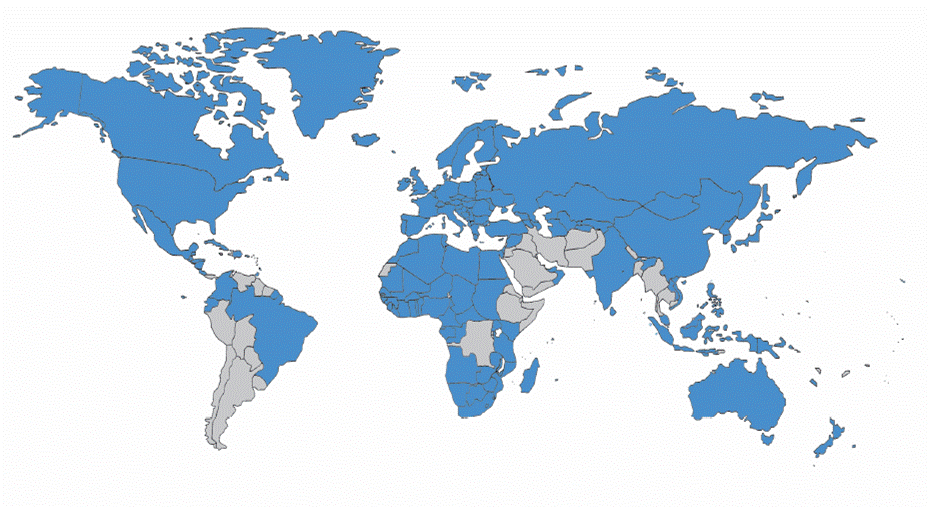
Note: It should be noted that even though the filing of a request constitutes under PCT Rule 4.9(a) the designation of all Contracting States bound by the PCT on the international filing date, for the grant of every kind of protection available and, where applicable, for the grant of both regional and national patents, applicants should always use the latest versions of the request form (PCT/RO/101) and demand form (PCT/IPEA/401) (the latest versions are dated April 2007) or, if filing the request using the PCT-EASY features of the PCT-SAFE software, the latest version of that software (which is available at: www.wipo.int/pct-safe).The request and demand forms can be printed from the web site, in editable PDF format, at: https://www.wipo.int/pct/en/forms/index.htm, or obtained from receiving Offices or the International Bureau or, in the case of the demand form, also from International Preliminary Examining Authorities.
11. MORE RESOURCES ON THE INTERNET
The following patent resources are available on the WIPO Internet:
| PATENTSCOPE® - WIPO's gateway to patent services and activities. | https://www.wipo.int/patentscope/en/ |
| Information on the PCT System | https://www.wipo.int/pct/en/ |
| PATENTSCOPE® search service - Search PCT International Applications and view/download complete patent applications and related documentation. | https://patentscope.wipo.int/search/en/search.jsf |
| PCT Statistics - monthly and yearly statistics on the PCT system, including comparative list of applicants and details of the indicators included in this report. | https://www.wipo.int/ipstats/en/statistics/pct/ |
| Law of Patents - includes current and emerging issues related to patents, information on WIPO-administered treaties, access to national/regional patent laws, patent law harmonization. | https://www.wipo.int/patent-law/en/ |
________________________________________
1 See official PCT fee tables [PDF]. Amounts can fluctuate with exchange rates.
2 Available at https://www.wipo.int/pct/en/basic_facts/faqs_about_the_pct.pdf
3 Regular updates are made at https://www.wipo.int/ipstats/en/
4 Provisional estimate - WIPO continues to receive PCT international applications filed with national Offices in 2007 throughout the first half of the year 2008.
5 In the following publication languages: English, French, German and Spanish
6 Provisional estimate - WIPO continues to receive PCT international applications filed with national Offices in 2007 throughout the first half of the year 2008.
7 Created by OST, INPI and FhG-ISI.
8 For further information on PCT national phase data, please refer to the Preface.
9 Transmittal under Rule 19.4 of the PCT Regulations.
10 https://patentscope.wipo.int/search/en/sequences.jsf
11 https://www.wipo.int/ipstats/en/statistics/patents/
12 https://www.wipo.int/ipstats/en/statistics/models/
13 Twelve Authorities are functioning in 2007 (see paragraph 7.2)
14 Some of these issues were later discussed by the PCT Assembly in October 2007
15 See "Statistical Sources" in the Preface
16 See EPC member States in Section 10
17 Available at https://www.wipo.int/pct/en/texts/glossary.html